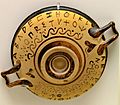Greek alphabet facts for kids
Quick facts for kids Greek alphabet |
|
|---|---|
| Type | Alphabet |
| Spoken languages | Greek |
| Time period | c. 800 BC – present |
| Parent systems |
Egyptian hieroglyphs
|
| Child systems |
|
| Unicode range |
|
| ISO 15924 | Grek |
| Note: This page may contain IPA phonetic symbols in Unicode. | |
The Greek alphabet is a writing system with 24 letters. It is used to write the Greek language. You might also see Greek letters used a lot in science and mathematics. They often stand for different things, like angles or numbers. Many Greek letters are similar to letters we use in the English language.
Contents
How the Greek Alphabet Started
The Greek alphabet is very old. Many important European alphabets, like the one we use for English, came from it. The Greeks got the idea for their alphabet from the Phoenician alphabet around 1000 BC.
The Greeks made some big changes to the Phoenician alphabet. The most important change was adding vowels. The Phoenicians wrote their alphabet without any vowels. Adding vowels made reading much easier for the Greeks. This change also worked better for languages like Greek, which use vowels more than languages like Arabic or Hebrew.
The Greeks also invented some new letters for sounds that were in Greek but not in the Phoenician language. At first, Greek was written from right to left, just like Phoenician. But after 600 BC, people started writing it from left to right.
Different Kinds of Greek Alphabets
In the beginning, the Greek alphabet was a bit different depending on where you were in Greece. There were two main types: eastern and western.
Over time, all Greeks started to use the same alphabet. This happened especially after the Ionic alphabet from a city called Miletus was chosen as the official alphabet in Athens in 403 BC. Soon after, the rest of Greece followed. By 350 BC, when Alexander the Great was alive, almost all Greeks used the same 24-letter Greek alphabet.
Adding Accent Marks
Later, a Greek scholar named Aristophanes of Byzantium (who lived around 257–185 BC) invented three special marks. These marks are called diacritics or accent marks. They are the acute, grave, and circumflex. They were used to show how to say Greek words, especially their tone or pitch.
How Greek Sounds Changed
Even though the Greek letters were good at showing the sounds of the language early on, the sounds themselves changed over time. Some vowel sounds started to sound alike. Also, some consonant sounds changed.
You can get an idea of how older Greek sounded by looking at how some Greek words are spelled in Latin and English. For example, words like "philosopher," "Chimera," "Cyprus," and "Thessalonica" show how the sounds used to be.
The "H" Sound in Greek
Another special mark in Greek is like a small comma above some vowels at the beginning of a word. This mark tells you if there is an 'H' sound before the vowel.
If this comma-like mark is reversed, it means there *is* an /h/ sound. For example, the Greek name Ἕκτωρ is said as Hektōr, not Ektor. Another example is ἥρως, which is pronounced hḗrōs, meaning "hero."
Modern Greek Writing
In 1982, the Greek government adopted a new, simpler way of writing called "monotonic." This system uses only one accent mark, the acute accent. This mark shows which syllable in a word should be stressed, especially in words with more than one syllable.
Related pages
Images for kids
-
Early Greek alphabet on pottery in the National Archaeological Museum of Athens
-
A 16th-century edition of the New Testament (Gospel of John), printed in a renaissance typeface by Claude Garamond
See also
 In Spanish: Alfabeto griego para niños
In Spanish: Alfabeto griego para niños






